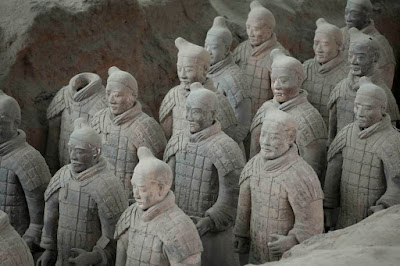Evelyn Cheng
@CHENGEVELYN
BEIJING — The Chinese city of Xi’an remains a bright spot of growth in a country still recovering from the shock of the coronavirus pandemic.
Xi’an is best known to many for its Terracotta Warriors — an army of clay sculptures from ancient times. Located in central China well over 800 miles from the east coast metropolis of Shanghai, Xi’an is one of the last major urban areas before the poorer regions of the west.
The city’s GDP grew 4.5% in the first three quarters of the year, the fastest of all major Chinese cities, according to Wind Information. Beijing city grew 0.1%, while Shanghai contracted 0.3% during the first nine months of the year, the data showed. National GDP is set for roughly 2% growth this year.
Xi’an’s rapid expansion reflects how local governments are trying to boost growth, while revealing questions about sustainability.
Tech
High-value manufacturing in industries such as aviation and pharmaceuticals as well as the development of transportation infrastructure have contributed significantly to Xi’an’s growth, said Perry Wong, managing director of research at the Milken Institute.
In the institute’s ranking this year of China’s “Best-Performing Cities” released on Dec. 17, Xi’an rose to fourth place, up from sixth place last year and ninth place in 2018.
High levels of foreign direct investment are another factor behind Xi’an’s growth, Wong said.
In the first three quarters of the year, Xi’an said it utilized $6.58 billion in foreign capital, a 7.2% rise from a year ago. That’s a faster increase than the 2.5% increase to $103.26 billion in foreign capital used nationwide, according to official data.
Samsung has invested more than $10 billion in Xi’an, where the company’s semiconductor unit has facilities for research and manufacturing. The South Korean company is reportedly stepping up its investment and sent hundreds of more engineers to the city earlier this year, according to The Korea Herald.
Some of the Chinese high-tech companies located in Xi’an include aircraft parts manufacturer Chenxi Aviation, AVIC XAC — a commercial aircraft manufacturer tied to state-owned defense and aerospace conglomerate AVIC — and Western Superconductor, which manufacturers titanium products and researches applications in aerospace, medical and other industries.
Housing
Helping those high-tech companies attract talent, and the city to build its wealth, are government policies that make it easy for university graduates to settle in Xi’an and buy a home. People in China are tied to their place of birth through the hukou system, which makes it hard for migrants to the largest cities like Beijing to buy apartments or send their children to local schools.
Relaxing hukou restrictions is a strategy in a growth race among China’s up-and-coming urban areas, so-called “new first-tier cities,” said Yimin Zhao, an assistant professor in the urban planning and management department at Renmin University. “They’re competing with each other to attract not only capital, not only high-tech, but also talent.”
In China’s development system, a population increase allows the local government to extend the city limits, get more land allocated for construction and make money from property deals, Zhao said.
Reflecting high demand — and likely speculation — Xi’an’s house prices soared a cumulative 46% in the three years through 2019, according to the Sweetome Hurun Global Price Index. The annual report by rental vacation home operator Sweetome and wealth tracker Hurun Report found that Xi’an retained the third spot globally last year by price increase, up 19.7%.
The gains have continued this year, albeit at a slower pace.
Prices for newly constructed commercial housing in Xi’an rose 7.1% in November from a year ago, according to the National Bureau of Statistics. That’s among the 10 fastest paces for 70 large and medium-sized cities.
The city’s influx of buyers and high-rise developments has attracted too many speculators, causing an unsustainable price bubble, while creating traffic and safety issues for an overly crowded city, said Yuan Guoqian, president of Xi’an Xiaoyuan Technology. The company’s research advocates that cities pursue more sustainable expansion through two or three-story townhouses.
Yuan said the idea is beginning to find some traction, and that a project in the Weinan region on the northeastern outskirts of Xi’an has nearly completed phase one, thanks to support from local authorities. “They understand no one wants this kind of high-density living,” he said, according to a CNBC translation of his Mandarin-language remarks.
Growth challenges
Xi’an’s popularity among tourists — a selling point for developers — has also been a downside in the wake of the coronavirus pandemic.
The city remained one of the 10 most popular tourist destinations in China this year, according to booking website Trip.com.
But since June, new business registrations in Xi’an have plunged roughly 40% from a year ago, while other major inland Chinese cities of Chengdu and Chongqing have seen increases of 15% and 7%, respectively. That’s according to Chinese business database Qichacha.
“This year, the economy isn’t as good as prior years, so there’s a limit (on consumer spending),” said Mao Wei, general manager of the Zhonghua County tourism area that’s under development about an hour’s drive from Xi’an. That’s according to a CNBC translation of his Mandarin-language remarks.
He said the number of visitors has begun to pick up since April. But he doesn’t expect much return on the years-long project until people begin to stay more at its hotels, and more residential and commercial parts are completed.
Speaking broadly about the tourism industry, Mao said, “Overall 2020 is not as good as 2019 because everyone lost money in the first quarter.”
Source : cnbc.com

